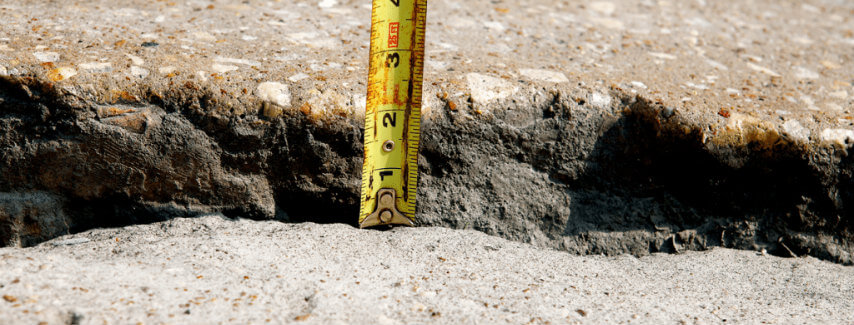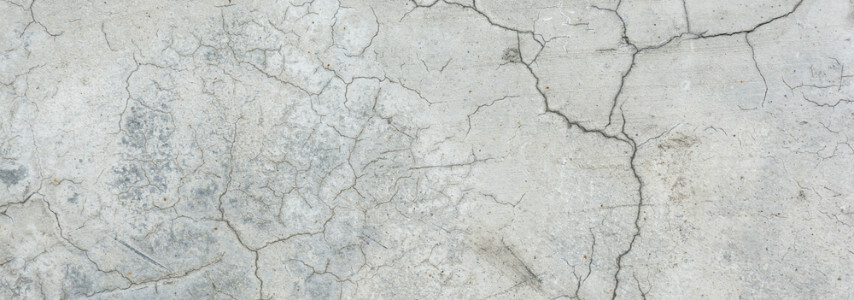No matter how sturdy a concrete foundation is, it can develop cracks or fissures. The cause of unwanted cracks in concrete can be due to prolonged exposure to natural environmental forces such as:
- Topsoil and subsurface earth layer erosions
- Repeated wetting and drying from rainwater seepage
- Damage from unchecked tree root encroachment on concrete slabs
- Naturally occurring foundation settling
To prevent extensive damage and higher maintenance costs, you must monitor cracking and contact a professional in the case of widespread cracking and settlement. Early detection and repairs will ensure that concrete slab cracks don’t necessitate costly foundation repair methods. What happens when you don’t fix foundation problems? You don’t want to know!
Is a Crack in a Slab Foundation Bad?
Cracks in a concrete slab can be signs of foundation issues, or they may just be superficial. Structural cracks in cement slab foundations can adversely affect various parts of the overlying structure. In severe cases, disruptions in slab continuity manifest as buckled walls with disfiguring cracks and crevices, leaning buildings, and broken-up floors with uneven or undulating surfaces. You may even notice cracks in walls and ceilings of the building.
A cracked slab can pose a significant problem to the building and structures overlying it as they will develop distortions that translate into critical but unplanned maintenance expenditures. There are many reasons for cracks in a concrete slab and it is difficult to know exactly what will work best on a case-by-case basis.
What Causes Concrete to Crack?
So, why does concrete crack? Various natural and artificial influences interact to cause concrete slabs to develop cracks. The following factors will determine the chances of cracks forming in a concrete foundation.
Uneven Sub-grade
Before laying a concrete foundation, the soil surface or sub-grade is primed. It is vital that an even surface is achieved before pouring a foundation slab. An uneven or undulating surface increases the probability that the finished slab will buckle and break up as it dries.
Poorly Constituted Concrete
Surplus water in a cement mixture significantly raises the chances of a completed concrete slab developing cracks. In addition, the rapid evaporation of extra water from the concrete mix will shrink the drying solution leading to the formation of fissures or cracks in concrete floors.
Poor Concrete Curing
It has been established that rapid drying of concrete will cause cracks in floor slabs. Concrete curing is a process that allows water elimination in a controlled manner. However, if curing is improperly done, the water evaporation will leave hairline cracks in the concrete slab.
6 Types of Cracks in Concrete Slabs
Different types of concrete cracks in buildings have been observed to develop over time regardless of the strength of the initial concrete mixture utilized in creating the foundation. These structural cracks in concrete slabs occur due to a combination of natural and artificial factors that are described below.
1. Settlement Cracks
Settlement cracks develop when the loosely aggregated soil beneath a concrete slab erodes or settles. Since the earth has settled, some concrete slab areas are unsupported and can crack from stress. Further, tree root decomposition will create pockets of weakness below building foundations into which their concrete slabs will settle and develop areas of breakage.
Foundation settling cracks can be problematic, especially if the damage is extensive. In these cases, the affected foundation may need repairs. If you see your foundation pulling away from your house or property, call an expert immediately.
2. Heaving Cracks
Tree roots can exert significant amounts of pressure on structures blocking the path of their spread. Unchecked, these tree roots can extend beneath foundation slabs and disrupt them, resulting in up-heaving cracks that elevate and break up the concrete slabs.
Tree root barriers can be a valuable measure for preventing this issue and preventing the construction soil under your concrete from losing moisture.
3. Plastic Shrinkage Cracks
This type of crack occurs when water escapes from the exposed upper surface faster than the lower part leading to uneven drying of the concrete slab. Simply keeping the surface moist during the setting process can help prevent these cracks from emerging.
Also, chemicals that hinder rapid moisture loss can be applied to the surface of the concrete to slow evaporation and ensure a more even cure.
4. Pressure Cracks
When the weight-bearing capacity of a concrete slab foundation is exceeded, fine cracks may develop on the surface. Heavy vehicles and building fixtures are the leading causes of pressure cracks. Typically, these types of cracks pose minimal risk to the overlying structures.
5. Crusting Cracks
Crusting cracks develop in concrete slabs that have been manipulated into shapes and patterns. Uneven drying of the wrought surfaces will cause fissures to form. Just like with crazing cracks, crust fissures do not require advanced repairs and can be fixed easily.
6. Crazing Cracks
These are tiny fissures that occur on the surface of a rapidly dried slab. These defects develop in a spider web or mosaic pattern. Crazing cracks pose little threat to the integrity of a foundation and don’t always require repair.
How long does it take to fix a foundation with these problems? The answer will vary depending on the severity of your situation and the expertise of the foundation repair company you hire. We’ve also provided some foundation problem pictures to help you identify what kind of crack you’re dealing with.
Benefits of Repairing Cracks in Foundation Slabs
Foundation repair is an important investment for your home or business. Foundations can crack and crumble due to age or shifting soil, which can cause severe structural problems. Foundation repair in the Greater Houston area can make a big difference in the life of your property by stabilizing the foundation to provide better protection from future damage. Additional benefits include:
- The property will be more structurally sound and less likely to have water damage.
- Residential properties may have a higher resale value if the foundation has been repaired.
- The building will be safer for residents, especially if they have children, elderly family members, pets, or medical conditions that require monitoring.
Contact URETEK for Solutions to Your Concrete Cracks & Foundation Problems
In conclusion, cracks in a new concrete slab are not uncommon and are often caused by extreme weather conditions, settling, or soil movement. Many of the concrete cracks discussed in this article can be a sign of foundation issues, as well as an indication that the concrete is drying out. If you find cracks in your structure’s concrete slab, it is best to consult with a professional who can determine if there are any underlying issues.
URETEK Gulf Coast has remained dedicated to offering its clients the best quality foundation repair in Houston for all types of private and public structures. Our foam foundation injection and pressed piling foundation repair methods will guarantee that you get the most satisfactory results. Our foundation repair before and after pictures speak for themselves.
Contact our team today if you’re based in Houston and would like more information about our commercial and home services!



